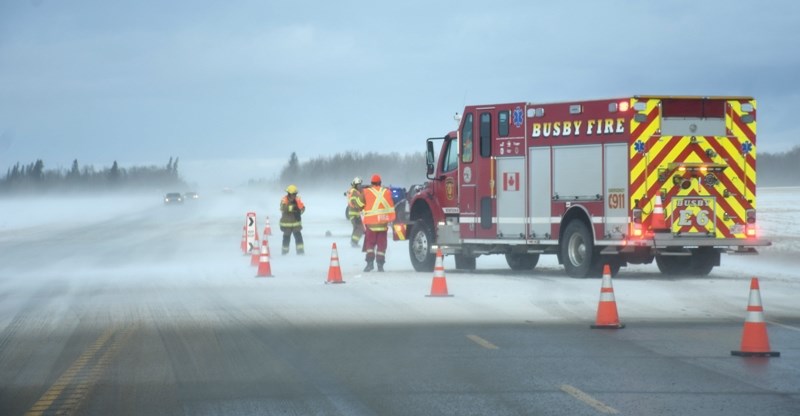Snow squalls and black ice made for a slippery drive on Highway 2 and Highway 44 Nov. 27 as hazardous conditions landed a few drivers in the ditch and threatened first responders.
Fire crews from the Town of Westlock and Westlock County were busy dealing with a two-vehicle collision on Highway 2 and Township Road 582 south of Vimy around 1 p.m. Later at around 4 p.m., fire crews were sent to a collision north of town on Highway 44 and Township Road 604. No one was taken to hospital with injuries.
Stuart Koflick, the town’s director of Emergency Management and fire chief, said his crew assisted the Busby and Pickardville fire departments with traffic control and highway clean up.
“The wind generated obviously dangerous driving conditions on Highway 2,” he said.
“In places across the highway there was zero visibility and snow drifting across the highway. It was very evident the wind was picking up throughout the afternoon, because when we left Westlock for this call and upon return, we could definitely tell the difference in driving conditions and the snowdrifts across the roads.”
While working at the scene can be dangerous, Koflick said first responders have to “be like an owl.”
“Your head’s on a swivel at all times,” he said. “Based on where the collision was, we staged ourselves quite a ways north of the collision in an area that was free of the blowing snow across the highway.”
He added that crews tried to be as visible as possible by wearing reflective gear, posting highway signs and a lookout person, and following a set of standard operating procedures.
One procedure involved stationing the emergency vehicle in such a way to protect the collision scene and the workers.
“We situate our apparatuses — that’s where we use the bigger types of trucks — in what’s called a ‘fend off’ position where we angle the unit so if there was a collision, the apparatus would be involved in the collision and the vehicle colliding with our trucks would be directed off the highway,” he said.
Blowing snow made for poor visibility on Highway 2, but at the Highway 44 incident it was slick road conditions and black ice that made for a treacherous expedition for motorists and emergency services personnel.
But staying at home isn’t an option for everyone.
“If we don’t arrive, we’re not able to help the people that we’re sent to help,” Koflick said. “Winter driving precautions are in effect, making sure that we drive to the road conditions. We’re not overdriving ourselves, we leave ourselves plenty of room to slowdown and stop when we’re approaching the collision scene, not following too closely.”
The same should be said of drivers who come across an emergency vehicle on the road, as fire crews and other first responders never know what they may encounter up ahead.
“People need to understand it’s not just pull over and slow down, it’s pull over and stop until the emergency vehicle is passed you,” Koflick said. “It’s under the Traffic Safety Act, you have to not follow within (150) metres of an emergency vehicle.”
On Highway 44, the black ice was so severe that Carillion had to be called to de-ice the roads, although Koflick said getting the sanding truck to the scene was a bit delayed.
“It’s a hazard to first responders as well,” he said. “We’re sliding all over the highway too. Even while the emergency operations are ongoing, we try to get the sanding truck in there, because that improves the scene 100 per cent for us. The unfortunate thing is, I don’t know how many miles of road Carillion has to maintain, but they can’t be everywhere at once.”
The scene also prevented tow trucks from doing their job so vehicles were left in the ditch until conditions improved the following day.
Koflick said a tow ban was put in place since it was too unsafe to have a tow truck on the side of the road trying to winch the vehicles out of the ditch. Vehicles left behind are usually flagged so that passersby can see that the scene has already been taken care of.
“A lot of times people will be driving by, see a vehicle in the ditch and think the collision just happened and/or don’t take the time to stop,” he said. “They just call 911, then they send the emergency vehicles out for no reason.”



